Despite an estimated Rs.1,000,000 crore having been poured into the country’s 1.25 million government primary schools over the past decade, there’s little to show for it. On the contrary, ASER 2010 indicates that learning outcomes in the country’s 1.05 million rural primaries have gone from bad to worse. Summiya Yasmeen reports
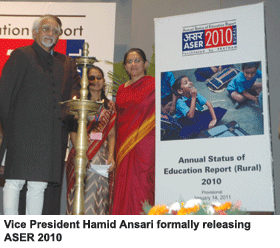 A full decade after launch of the ambitious Sarva Shiksha Abhiyaan (Education for All) initiative in the new millennium; introduction of the free primary school mid-day meal scheme; imposition of a 2 percent cess for primary education (2004); passage of the historic Right to Free and Com-pulsory Education Act, 2009 and an estimated Rs.1,000,000 crore having been poured into the country’s 1.20 million government primary schools over the past decade, there’s little to show for it. On the contrary, learning outcomes in the country’s 1.05 million government rural primaries and upper primaries have gone from bad to worse.
A full decade after launch of the ambitious Sarva Shiksha Abhiyaan (Education for All) initiative in the new millennium; introduction of the free primary school mid-day meal scheme; imposition of a 2 percent cess for primary education (2004); passage of the historic Right to Free and Com-pulsory Education Act, 2009 and an estimated Rs.1,000,000 crore having been poured into the country’s 1.20 million government primary schools over the past decade, there’s little to show for it. On the contrary, learning outcomes in the country’s 1.05 million government rural primaries and upper primaries have gone from bad to worse.
That’s the gloomy verdict of the Annual Status of Education Report (ASER) 2010, published by the highly-respected Mumbai-based education NGO Pratham (estb.1994) and released by vice president Hamid Ansari in Delhi on January 14. The purposive labour of love of over 25,000 volunteers (mainly higher secondary and undergraduate students) who fanned out across 522 districts of rural India starting last September, ASER 2010 is an audit report of actual learning outcomes of children in 13,000 (mainly government) sample primaries in rural India.
This latest edition of ASER which has been published annually by Pratham since 2005, reveals that even as the gross enrolment ratio (GER) in primary education has risen from 95 percent in 2009 to 96.5 percent in 2010, the percentage of class V children who can read class II texts has declined from 58 percent in 2007 to 53.4 percent in 2010, indicating that very little by way of improved learning outcomes is happening in the classrooms of rural primaries run by indifferent state governments. Moreover ASER 2010 also records a decline in children’s maths learning capability. The proportion of class I children who can recognise numerals has declined from 69.3 percent in 2009 to 65.8 percent in 2010. Conterminously the percentage of class III children who can do two-digit subtraction sums has declined further from an already shocking 39 percent to 36.5 percent even as the proportion of class V children who can complete simple division sums has dropped from 38 to 35.9 percent.
In an invaluable performance audit service rendered free of charge since 2005, Pratham has been conducting this exercise annually to measure learning outcomes in rural India. Unfortunately — perhaps inevitably — these independent annual reports on the quality of primary education dispensed in the country’s 1.05 million rural primaries and upper primaries — 80 percent of which are owned and managed by state governments — indicate that taxpayers are getting precious little return on investment in education. An estimated Rs.185,000 crore (half the country’s Rs.372,000 crore education expenditure) was spent by the Centre and 28 state governments on primary education in 2010-11.
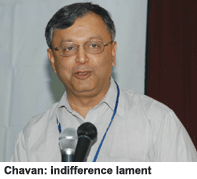 “In 2005 we started measuring the impact of the 2 percent education cess levied by the the UPA-I government on a wide range of goods and services to raise additional funding for elementary education with the promise of matching outcomes and outlays. But while the number and percentage of children attending primary schools in rural India have substantially increased since 2005, the child who enroled in class I in 2006 and who is in class V today is no better off than the child who was in class V in 2006. ASER 2010 indicates that the impact of five years of schooling on children who entered class I in 2005 is hardly greater than upon children who entered class I in 2001. If anything their ability to read seems to have dropped a couple of notches over the five-year span. Likewise the all-India average of children who can do simple math has also declined by a few percentage points over the past four years. For a country that aspires to become a superpower, this is a very alarming situation. Unfortunately unlike US President Barack Obama, no Indian leader of national stature appears to be worried about the problem of stagnant learning outcomes in primary schools,” says Madhav Chavan, an alumnus of Ohio State University and former reader in physical chemistry at Mumbai University, who founded Pratham in 1994 with the objective of raising standards of primary education countrywide.
“In 2005 we started measuring the impact of the 2 percent education cess levied by the the UPA-I government on a wide range of goods and services to raise additional funding for elementary education with the promise of matching outcomes and outlays. But while the number and percentage of children attending primary schools in rural India have substantially increased since 2005, the child who enroled in class I in 2006 and who is in class V today is no better off than the child who was in class V in 2006. ASER 2010 indicates that the impact of five years of schooling on children who entered class I in 2005 is hardly greater than upon children who entered class I in 2001. If anything their ability to read seems to have dropped a couple of notches over the five-year span. Likewise the all-India average of children who can do simple math has also declined by a few percentage points over the past four years. For a country that aspires to become a superpower, this is a very alarming situation. Unfortunately unlike US President Barack Obama, no Indian leader of national stature appears to be worried about the problem of stagnant learning outcomes in primary schools,” says Madhav Chavan, an alumnus of Ohio State University and former reader in physical chemistry at Mumbai University, who founded Pratham in 1994 with the objective of raising standards of primary education countrywide.
The pronouncements of ASER 2010 — and Madhav Chavan — on the status of primary/elementary education in India, which grudgingly hosts the world’s largest child population (450 million) and whose political and business leaders express eagerness to encash the country’s unplanned ‘demographic dividend’, merit the serious consideration of the Union HRD (human resource develop-ment) ministry and educationists and academics in particular. Because over the past six years Pratham has trans-formed into a high-quality education think tank and NGO. Currently it reaches over 2.5 million children with its supplementary pre-school, in-school and out-of-school programmes in 19 states across India.
A unique example of a tripartite partnership between state governments, corporates and NGOs, it is widely respected abroad particularly by the NRI community from whom it raises Rs.16 crore annually, enabling Pratham to boast an annual budget of Rs.72 crore (2010). For instance Pratham conducts several fundraising events in the UK annually, including the London Marathon, British 10 km Run and the Pratham Gala, a high-profile black-tie charity dinner attended by the rich and famous including Lakshmi Mittal, the Hindujas, M.F. Hussain, Lord and Lady Mitchell, which raised £1.6 million (Rs.11.7 crore) last year.
Given that primary education across the country is the province of state governments, a particularly useful feature of the ASER reports is that it also details learning outcomes of children measured by reading and maths capability, in all states of the Indian Union (except Jammu & Kashmir). And unsurprisingly ASER 2010 highlights the well-known truth that primary education learning outcomes in the Hindi-belt BIMARU (Bihar, Madhya Pradesh, Rajasthan and Uttar Pradesh) states are well below the all-India average.
In the northern states, there’s been a decline in the percentage of enroled children who can read and comprehend adequately over the past four years. Bihar indicates a 9.4 percent decline in the number of class V children who can read class II texts even while recording a remarkable leap in primary enrolment (from 93.6 percent in 2007 to 96.5 percent in 2010). On the other hand, children in rural primaries in Punjab and Kerala have improved their reading and comprehension skills. The worst teachers are in Uttar Pradesh, Orissa and Assam where reading ability of class V children has dipped 2.8-7.2 percentage points over the past four years and is well below the national can-read average of 53.4 percent.
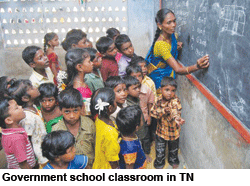 Surprisingly the southern state of Tamil Nadu (pop. 62 million), popularly believed to be among the most progressive and educationally developed states of the Indian Union, has been shown in poor light in ASER 2010. Shockingly over 69 percent of class V children in Tamil Nadu’s rural primaries cannot read class II texts (cf. the national average of 46.6 percent) and 80 percent of class III children cannot read class I texts. Even more surprisingly, this southern littoral state fares equally poorly in maths ability with 85 percent of class V children unable to do simple division sums (cf. 64 percent national average).
Surprisingly the southern state of Tamil Nadu (pop. 62 million), popularly believed to be among the most progressive and educationally developed states of the Indian Union, has been shown in poor light in ASER 2010. Shockingly over 69 percent of class V children in Tamil Nadu’s rural primaries cannot read class II texts (cf. the national average of 46.6 percent) and 80 percent of class III children cannot read class I texts. Even more surprisingly, this southern littoral state fares equally poorly in maths ability with 85 percent of class V children unable to do simple division sums (cf. 64 percent national average).
These conclusions of ASER 2010 pertaining to Tamil Nadu indicate that the celebrated Activity Based Learning (ABL) pedagogy introduced by the state government specifically to improve children’s learning compet-encies has been a failure. In 2003 the AIADMK-led government introduced ABL — reportedly a flexible, child-centric pedagogy which permits children to study at their own pace and encour-ages self-learning — on an experimental basis in government schools in Chennai and subsequently extended it to all its 37,486 government schools across the state despite protests by teachers associations. Since introduction of ABL, the state government claims the quality of education dispensed in its schools has improved dramatically. In fact, a state-sponsored survey by SchoolScape conducted in 2007-08 certified a significant improvement (20-30 percent) in the reading and numeracy skills of children after ABL was introduced.
But with ASER 2010 contradicting the SchoolScape survey, the state’s education bureaucrats are in a lather and tend to be dismissive about the ASER survey’s assessment methodology. Comments R. Venkatesan, project director of Sarva Shiksha Abhiyaan in Tamil Nadu: “Learning outcomes have improved considerably after ABL was implemented in the state’s elementary schools and is now being emulated by 18 other states. We disagree with the conclusions of ASER reports which strangely indicate declining learning outcomes in Tamil Nadu’s rural schools. We don’t know what methodology ASER volunteers employ while conducting surveys. ABL has definitely improved learning outcomes in primary education in Tamil Nadu and will remain our prime strategy to improve learning outcomes of children in government schools in this state.”
However Chavan counters criticism of the ASER survey methodology, pointing out that SchoolScape measured the learning achievements of the same students at the beginning and end of the academic year in which ABL was introduced. “A progress of 20-30 percent in learning outcomes over one academic year is also observed by ASER. But the same difference was observed before and after ABL was introduced. The point is whether ABL has improved learning outcomes. There is no evidence of that. On the contrary, ASER measures learning levels in each class year after year and sees no change. The ASER Centre is willing to share its methodology and process with the Tamil Nadu government but the government is resistant to any external independent agency evaluating its schools,” says Chavan.
While there’s possibly a massive fudging scam brewing in Tamil Nadu — it’s hardly disputable that Pratham’s expertise and credibility is far greater than of SchoolScape or the scandal-ridden DMK government of Tamil Nadu — ASER 2010 is not entirely a gloom-n-doom narrative. Some states have shown improved learning outcomes in rural schools. Among them is Punjab (pop.24 million). This northern state has shown dramatic improvements in reading and numeracy scores over the past three years (2008-10). The percentage of class V children in rural Punjab able to read and understand class II texts has increased from 61 percent in 2008 to 69.7 percent in 2010. Likewise the proportion of class V children who can do simple division sums has sharply increased from 43.5 percent in 2008 to 69.8 percent in 2010.
Monitors of Punjab’s education scene ascribe this jump in learning outcomes to the Purrho Punjab campaign launched by the Akali Dal-led government in 2007 in partnership with Pratham. The campaign set minimum learning goals for primary school children and improved students’ comprehension through simple activities in class, appointed “educated young teachers”, created “cluster leadership” within teachers to share best practices and encouraged “community youth” to regularly visit rural primaries and demand teacher accountability.
The lesson for other state govern-ments is that strong leadership, clear policies and continuous focus on improving learning outcomes can transform classrooms into child-friendly learning centres. Indeed ASER 2010 is a gold mine of information providing data needed by state governments upon which base they can radically transform the quality of education dispensed in rural schools.
ASER 2010 differs from its predecessors in that it also presents the first-ever status report on the extent to which rural government schools are conforming with the norms mandated by the RTE Act, 2009 which came into force in April last year. The Act specifies minimum infrastructure, teacher appointment, teaching learning material and pupil-teacher ratio norms. While visiting 13,000 sample villages, ASER volunteers also observed and recorded the local primary school’s compliance with RTE norms.
Encouragingly the volunteers found that over 60 percent of the 13,000 schools visited satisfied the infrast-ructure norms specified by the RTE Act. For instance 62.1 percent of rural primaries have playgrounds, 81 percent kitchen sheds, 72.2 percent provide drinking water, and 90 percent offer toilet facilities (although toilets were usable in only 51.1 percent of schools).
However teacher absenteeism/truancy is still a big problem in government rural primaries and is getting worse. The percentage of teachers present on the day of volunteers’ visit has steadily decreased from 73.7 percent in 2007 to 69.2 percent in 2009 and 63.4 percent in 2010. The on-the-ground impact of mass teacher absenteeism, which is a defining characteristic of the government — especially rural government — school system, is that 1.25 million teachers countrywide are absent from duty on any given school day. This is undoubtedly the prime cause of the deplorable learning outcomes in rural primaries highlighted in ASER 2010 and contributes to the peculiarly Indian phenomena of multi-grade teaching, uncovered syllabuses, high percentage of school drop-outs and pathetic board exam pass percentages.
However the better than expected state of primary schools’ infrastructure reported in ASER 2010 indicates that the Central government’s flagship Sarva Shiksha Abhiyaan (SSA) campaign and the Rs.1,000,000 crore allocated to the programme over the past decade has been mainly expended on building and upgrading infrastructure, leaving little for teacher training and pedagogy development. Unfortunately the recently enacted RTE Act, which guarantees all children between the ages of six-14 compulsory elementary education (class I-VIII), follows the same path. While the Act details elaborate infrastructure requirements, it shockingly fails to specify minimum learning outcomes and competencies children must attain at various stages of primary schooling. Worse, it absolves teachers of all accountability. Confronted with the prospect of a revolt within the nation’s 5.5 million primary teachers’ community, the Central government dropped a provision in the draft RTE Bill empow-ering school management committees to monitor teacher attendance with the discretion to penalise absenteeism.
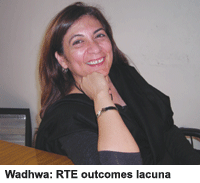 “Inputs are necessary and are easier to target and monitor. But if we believe that education entails more than just being enroled in school, then at some level we have to have a set of outcomes that we expect the education process to lead to. The outcome is learning, defined in some manner, and its necessary pre-requisite ‘attendance’ of both teachers and children in school. Unless children and teachers attend school and instruction takes place, learning, however defined, will not take place no matter how many classrooms, toilets and playgrounds are built. Unfortunately, the RTE falls short in specifying expected outcomes of a child being enroled in school,” writes Dr. Wilima Wadhwa, an economics alumna of Delhi and California univer-sities and director of statistics at the ASER Centre in Delhi, in an analytical essay included in ASER 2010.
“Inputs are necessary and are easier to target and monitor. But if we believe that education entails more than just being enroled in school, then at some level we have to have a set of outcomes that we expect the education process to lead to. The outcome is learning, defined in some manner, and its necessary pre-requisite ‘attendance’ of both teachers and children in school. Unless children and teachers attend school and instruction takes place, learning, however defined, will not take place no matter how many classrooms, toilets and playgrounds are built. Unfortunately, the RTE falls short in specifying expected outcomes of a child being enroled in school,” writes Dr. Wilima Wadhwa, an economics alumna of Delhi and California univer-sities and director of statistics at the ASER Centre in Delhi, in an analytical essay included in ASER 2010.
As if to reiterate official indifference to learning outcomes, s.16 of the RTE Act states that no child admitted in school should be held back in class or expelled for academic non-performance until completion of upper primary education. While the intention behind this provision — sparing young children the stress of exams and humiliation of detention — is laudable, there’s an emerging consensus among education-ists that this ill-conceived provision will further dilute standards in primary education.
“Learning outcomes will definitely deteriorate because of the RTE Act prohibiting detention of all children until class VIII. Though the laudable inten-tion is to reduce the stress of learning in the primary years, some evaluation is required to assess children’s learning capabilities. However, on the positive side, the RTE Act speaks of compre-hensive schooling and for the first time, the education department, parents, local bodies and civil society have been made equal partners in the pursuit of qualitative education. This may result in the public demanding accountability and better learning outcomes,” says Dr. I. Devasahayam, director of the Institute of Human Rights Education, Chennai.
Yet the most dangerous fallout of consistently declining learning outcomes in primary education is that ill-educated and ill-prepared students are being fed into the nation’s 100,000 secondary schools and subsequently, tertiary education institutions. Children with weak foundational education are certain to be a drag on the secondary and higher education systems, contributing to dumbing down of academic standards and ultimately swelling the pool of unemployable youth. This explains a glaring contrad-iction of contemporary India — skilled labour and professionals shortages in a 1.2 billion-strong nation with the world’s largest youth population.
.gif) “There’s no doubt that Indian taxpayers are getting nothing for their investment in public education. The quality of education dispensed in government primary schools in particular is so pathetic that children are unable to catch up in middle and secondary school. While state budgets are increasing allocations for education, they seldom address basic problems — teacher absenteeism and accountability, and worsening learning outcomes. Our demographic advantage is nullified by the poor quality of students who will ultimately join the ranks of the unemployed or more accurately, unemployables. This is a very dangerous situation and can lead to widespread social unrest. ASER 2010 is a wake-up call to state governments to act immediately,” says Dr. D.K. Srivastava, the Chennai-based director of the Madras School of Economics.
“There’s no doubt that Indian taxpayers are getting nothing for their investment in public education. The quality of education dispensed in government primary schools in particular is so pathetic that children are unable to catch up in middle and secondary school. While state budgets are increasing allocations for education, they seldom address basic problems — teacher absenteeism and accountability, and worsening learning outcomes. Our demographic advantage is nullified by the poor quality of students who will ultimately join the ranks of the unemployed or more accurately, unemployables. This is a very dangerous situation and can lead to widespread social unrest. ASER 2010 is a wake-up call to state governments to act immediately,” says Dr. D.K. Srivastava, the Chennai-based director of the Madras School of Economics.
Such indignation about deplorable conditions in the country’s 1.20 million government primaries characterised by chronic teacher truancy and abysmal learning outcomes as catalogued by ASER 2010 — and the forthcoming catastrophic consequences thereof — is rare. In most developed countries, such a damning report would provoke riots and topple governments. But it’s a telling commentary of the low official and societal importance accorded to public primary education that except for a few homilies about the need to improve learning outcomes uttered by politicians, there’s been no response from the Centre and/or state govern-ments to ASER 2010 and its shocking conclusions.
Given such political apathy and indifference to teaching-learning standards in government primaries, it’s hardly surprising that even dirt-poor parents in rural India — where the average per capita income is a mere Rs.21,630 per annum (cf. Rs.33,280 all-India) — are pulling children out of free-of-charge government schools and enroling them en masse in fees-levying private primaries. One of the major revelations of ASER 2010 is that private school enrolment of children in the age group four-16 in rural India has steadily increased from 16.3 percent in 2005 to 21.8 percent in 2009 and 24.3 percent in 2010. The southern states of Andhra Pradesh (29.7 percent in 2009 to 36.1 percent in 2010); Tamil Nadu (19.7 percent to 25.1 percent); Karnataka (16.8 percent to 20 percent) and Kerala (51.5 percent to 54.2 percent) have recorded the highest incre-ases in private school enrolment.
The ASER survey also confirms the reading and maths ability of children in private rural schools countrywide including these four southern states is 8-10 percentage points higher than of government school children. For instance in Karnataka 55 percent of private school class V children can read and under-stand class II texts compared to a mere 43 percent of class V government school students.
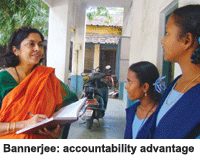 “The rising number of children enroling in private primaries nationally and in rural Karnataka is because parents are exercising an option which is now increasingly available. Though teachers in private schools may not be better, the accountability is better. Moreover private schools offer English-medium education which government vernacular schools don’t offer. But overall as ASER 2010 shows, learning outcomes in rural Karnataka’s schools are below the national average. The state government needs to seriously address this problem by investing heavily in teacher training and pedagogy innovation to ensure children develop basic competencies in reading and math,” says Kanchan Bannerjee, managing trustee of the Akshara Foundation, a Bangalore-based NGO (estb. 2000 as a Pratham affiliate by Rohini Nilekani, a major shareholder of the IT behemoth Infosys Technologies) which offers pre-school and in-school programmes for children and capacity building programmes for teachers in government primary schools.
“The rising number of children enroling in private primaries nationally and in rural Karnataka is because parents are exercising an option which is now increasingly available. Though teachers in private schools may not be better, the accountability is better. Moreover private schools offer English-medium education which government vernacular schools don’t offer. But overall as ASER 2010 shows, learning outcomes in rural Karnataka’s schools are below the national average. The state government needs to seriously address this problem by investing heavily in teacher training and pedagogy innovation to ensure children develop basic competencies in reading and math,” says Kanchan Bannerjee, managing trustee of the Akshara Foundation, a Bangalore-based NGO (estb. 2000 as a Pratham affiliate by Rohini Nilekani, a major shareholder of the IT behemoth Infosys Technologies) which offers pre-school and in-school programmes for children and capacity building programmes for teachers in government primary schools.
The vital message of ASER 2010 to state governments is that providing better infrastructure to get children into primary school is a necessary but insufficient condition. The greater challenge is to ensure that once in school, children receive real rather than ritual education. Incremental outlays for elementary education infrastructure and massive teacher recruitment drives serve little purpose if children don’t show improved learning outcomes. The damning conclusion of ASER 2010 is in effect a plea to state governments to shift focus from outlays to outcomes in primary education.
Moreover although the 254-page ASER 2010 doesn’t directly criticise the RTE Act, 2009 for mandating automatic promotion of all children until class VIII, it repeatedly alludes that official aversion to testing and measuring children’s knowledge — now legalised by RTE — is a prime cause of stagnant learning outcomes in elementary education. Instead of promoting academic rigour and continuous testing and assessment which requires teachers’ dedication and performance, the Central and state governments have taken the soft option of propagating the “holistic and all-round development of children”.
According to Madhav Chavan, the visionary promoter-chief executive of Pratham and the moving spirit behind the invaluable annual ASER surveys which rigorously audit learning outcomes in rural primaries, there’s a powerful lobby within academia with complete disregard for learning outcomes, and which “believes in the process rather than the end” of foundat-ional school education. “There’s a compelling need to define learning outcomes and attain them. For instance 80 percent of children in class III should be able to read and comprehend at least class I texts fluently, be able to recognise numerals and count up to 1,000 while understanding their place values. Moreover 80 percent of children in class V must be able to read, understand and solve simple math problems involving multiplication and division. If uncompromising goals are set for language and maths learning till class V, there’s a solid base to build upon. The example of Punjab and some other states shows that when govern-ments uncompromisingly set learning goals and re-orient the system to attain them, real learning is possible. So the mantra should be focus, focus, focus,” says Chavan.
Six years on since Pratham published its first report, ASER 2010 indicates that while massive public investment in the SSA elementary education initiative has pushed the average GER in primary education to 96.5 percent and prompted improvement of school infrastructure, learning outcomes are declining, resulting in massive wastage of fiscal and human resources. The intelligent response to ASER 2010 of Shastri Bhavan in Delhi and education ministries in the states would be to exercise mid-course correction and urgently shift the focus in elementary education from inputs/outlays to outcomes.
ASER 2010 reiterates that beyond the cacophony of metropolitan television channels and the real-politik-obsessed mainstream press, there’s a huge scam of continuous and uninterr-upted wastage of financial and human resources. It has decisively exposed the hollowness of the claim of New Delhi and supra nationalist cheerleaders that shining India is nurturing its demographic windfall.
With Autar Nehru (Delhi) & Hemalatha Raghupathi (Chennai)